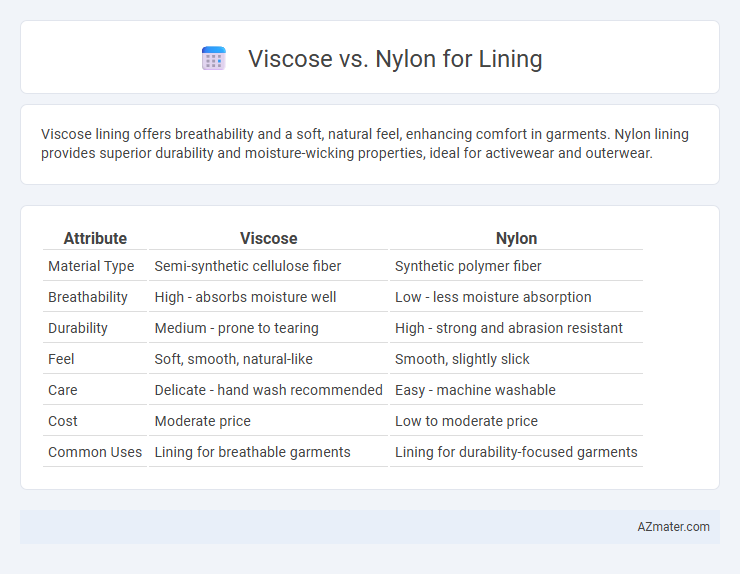Viscose lining offers breathability and a soft, natural feel, enhancing comfort in garments. Nylon lining provides superior durability and moisture-wicking properties, ideal for activewear and outerwear.
Table of Comparison
| Attribute | Viscose | Nylon |
|---|---|---|
| Material Type | Semi-synthetic cellulose fiber | Synthetic polymer fiber |
| Breathability | High - absorbs moisture well | Low - less moisture absorption |
| Durability | Medium - prone to tearing | High - strong and abrasion resistant |
| Feel | Soft, smooth, natural-like | Smooth, slightly slick |
| Care | Delicate - hand wash recommended | Easy - machine washable |
| Cost | Moderate price | Low to moderate price |
| Common Uses | Lining for breathable garments | Lining for durability-focused garments |
Introduction to Viscose and Nylon Linings
Viscose linings, derived from regenerated cellulose fibers, offer a smooth, breathable, and moisture-absorbent fabric ideal for comfort and thermal regulation in garments. Nylon linings, made from synthetic polyamide fibers, provide exceptional durability, elasticity, and resistance to abrasion, making them suitable for high-performance and heavy-use clothing. Both materials serve distinct purposes in lining, with viscose favoring softness and breathability, while nylon excels in strength and elasticity.
Key Differences Between Viscose and Nylon
Viscose lining offers excellent breathability and moisture absorption, making it ideal for comfort in warm or humid conditions, while nylon lining excels in durability, water resistance, and elasticity, suitable for activewear and outerwear. Viscose is a semi-synthetic fiber derived from cellulose, providing a soft, luxurious feel but prone to wrinkles and less resistance to abrasion compared to nylon, a fully synthetic polymer known for its high tensile strength and fast drying properties. The choice between viscose and nylon for lining depends on desired fabric performance, with viscose prioritizing comfort and natural texture and nylon focusing on functionality and resilience.
Comfort and Breathability Comparison
Viscose lining offers superior breathability due to its natural cellulose fibers, allowing better moisture absorption and air circulation, which enhances comfort in warm climates. Nylon, derived from synthetic polymers, provides durability and resistance to wear but tends to trap heat and moisture, reducing overall breathability and comfort during extended wear. For garments prioritizing ventilation and softness, viscose is the preferable choice, whereas nylon suits applications demanding higher abrasion resistance.
Durability and Longevity Factors
Viscose linings offer a smooth, breathable texture but tend to degrade faster under friction and moisture exposure, leading to reduced durability over time. Nylon linings provide superior strength and resistance to abrasion, making them highly durable and extending the longevity of the garment. When prioritizing lifespan, nylon is the preferred choice for linings in high-wear applications due to its robust fiber composition and resistance to stretching or tearing.
Moisture Management and Absorbency
Viscose excels in moisture absorbency, effectively wicking sweat away from the skin to enhance comfort in linings, while nylon offers superior moisture management by drying quickly and maintaining breathability. Viscose's natural fiber composition allows it to absorb up to 50% of its weight in moisture, making it ideal for applications where sweat absorption is crucial. Nylon's synthetic structure provides durability and fast-drying properties, reducing moisture buildup and preventing clamminess in activewear linings.
Care and Maintenance Requirements
Viscose lining requires gentle washing with mild detergents and air drying to maintain fabric integrity, as it is prone to shrinkage and damage from high heat. Nylon lining offers greater durability and is machine washable, drying quickly without losing shape, making it low-maintenance. Proper care extends the lifespan of both materials, but nylon's resilience suits activewear and frequent use better than viscose.
Environmental Impact and Sustainability
Viscose is a semi-synthetic fiber derived from cellulose, which is biodegradable but often involves intensive chemical processing and deforestation, raising sustainability concerns. Nylon, a synthetic polymer produced from petrochemicals, has a significant carbon footprint and is non-biodegradable, contributing to microplastic pollution. Eco-friendly alternatives include recycled nylon and lyocell-based viscose, which reduce environmental impact through sustainable sourcing and improved manufacturing processes.
Cost Considerations for Lining Fabrics
Viscose lining fabric generally offers a more affordable option compared to nylon, making it a popular choice for budget-conscious garment production. Nylon, while slightly more expensive, provides superior durability and moisture resistance, which can justify the higher initial cost in performance-focused applications. Manufacturers weigh these cost differences against the intended use and longevity of the lining to determine the best fabric choice for specific designs.
Best Uses: When to Choose Viscose or Nylon
Viscose linings excel in breathability and moisture absorption, making them ideal for lightweight garments, summer wear, and formal clothing requiring comfort and a natural feel. Nylon linings offer superior durability, water resistance, and elasticity, suited for activewear, outerwear, and garments exposed to frequent friction or moisture. Choose viscose when prioritizing softness and breathability, while nylon is best for robust, long-lasting linings with enhanced resistance to wear and environmental factors.
Conclusion: Which Lining is Right for You?
Viscose lining offers breathability and a soft, natural feel ideal for comfort in warm climates, while nylon lining excels in durability, water resistance, and ease of care, making it suitable for activewear or outerwear. Choosing between viscose and nylon depends on your priorities: opt for viscose if comfort and natural fiber are paramount, and select nylon for longevity and moisture resilience. Understanding the intended use and environmental conditions will help determine the best lining material for your garment.

Infographic: Viscose vs Nylon for Lining
 azmater.com
azmater.com